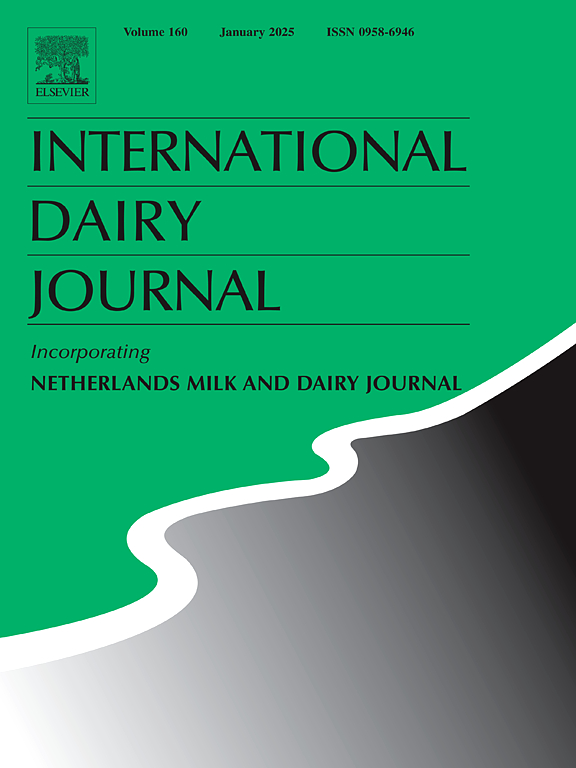软/半软、硬/半硬奶酪体外消化模型及研究进展
IF 3.4
3区 农林科学
Q2 FOOD SCIENCE & TECHNOLOGY
引用次数: 0
摘要
奶酪在世界各地的许多饮食中都是至关重要的,每种奶酪都具有不同的物理化学特性,影响其营养结果和消化率。奶酪结构和成分显著影响奶酪消化动力学,其中水分含量是软质奶酪消化率高于硬质奶酪消化率的关键因素。体外消化模型,如INFOGEST,通常用于研究奶酪分解、肽谱、营养物质释放和益生菌存活。人体肠道微生物生态系统模拟器、动态胃肠消化系统模拟器、人体胃模拟器等动态模型也已应用于各种奶酪。奶酪成分与宏量营养素和微量营养素的消化有关,特别是高脂肪含量,在奶酪消化结束时促进更快的分解和质地变化以及更有效的脂肪释放。较长的成熟时间可以促进蛋白质水解,增加肽浓度,并改善奶酪中某些矿物质的生物可及性。此外,降低蛋白质与脂肪的比例可以提高维生素D的生物可及性。奶酪也是益生菌和包封剂的有效载体,如高油酸棕榈油,它们的保留动力学需要消化研究。此外,用于奶酪的静态模型提供了关于肽谱和益生菌存活的近似动态模型的结果。然而,微生物群的相互作用和奶酪的大肠发酵尚未得到充分研究。本文重点介绍了奶酪的体外消化模型和研究,强调需要先进的系统,将静态和动态阶段结合起来,同时结合大肠模拟来评估营养物质的生物利用度和益生菌的存活,从而更全面地了解奶酪消化行为及其对人类健康的影响。本文章由计算机程序翻译,如有差异,请以英文原文为准。

A review of In vitro digestion models and studies for soft/semisoft and hard/semihard cheeses
Cheeses are vital for many diets worldwide, and each cheese type presents distinctive physicochemical properties that influence its nutritional outcomes and digestibility. Cheese structure and composition significantly affect cheese digestion kinetics, with moisture content being a key factor influencing a higher digestion rate in soft cheese than in hard cheeses. In vitro digestion models, such as INFOGEST, are commonly used to study cheese disintegration, peptide profile, nutrient release, and probiotic survival. Dynamic models like the Simulator of the Human Intestinal Microbial Ecosystem, the Dynamic Gastrointestinal Digestion System, and the Human Gastric Simulator have also been applied to various cheeses. Cheese composition correlates with macro and micronutrient digestion, particularly high-fat content, promoting faster disintegration and textural changes and more efficient fat release at the end of cheese digestion. Longer ripening times could enhance proteolysis, increase peptide concentration, and improve the bioaccessibility of certain minerals in cheeses. Additionally, a reduction in the protein-to-fat ratio can improve vitamin D bioaccessibility. Cheeses also serve as an effective carrier for probiotics and encapsulating agents, i.e., high oleic palm oil, and their retention kinetics required digestion studies. Moreover, static models employed for cheeses provided results that approximate dynamic models regarding peptide profiling and probiotic survival. However, microbiota interactions and large intestinal fermentation for cheeses are underexplored. This review highlighted the in vitro digestion models and studies on cheeses, stressing the need for advanced systems that integrate both static and dynamic phases while incorporating large intestinal simulation to assess nutrient bioavailability and probiotic survival, leading to a more comprehensive understanding of cheese digestion behavior and its impact on human health.
求助全文
通过发布文献求助,成功后即可免费获取论文全文。
去求助
来源期刊

International Dairy Journal
工程技术-食品科技
CiteScore
6.50
自引率
9.70%
发文量
200
审稿时长
49 days
期刊介绍:
The International Dairy Journal publishes significant advancements in dairy science and technology in the form of research articles and critical reviews that are of relevance to the broader international dairy community. Within this scope, research on the science and technology of milk and dairy products and the nutritional and health aspects of dairy foods are included; the journal pays particular attention to applied research and its interface with the dairy industry.
The journal''s coverage includes the following, where directly applicable to dairy science and technology:
• Chemistry and physico-chemical properties of milk constituents
• Microbiology, food safety, enzymology, biotechnology
• Processing and engineering
• Emulsion science, food structure, and texture
• Raw material quality and effect on relevant products
• Flavour and off-flavour development
• Technological functionality and applications of dairy ingredients
• Sensory and consumer sciences
• Nutrition and substantiation of human health implications of milk components or dairy products
International Dairy Journal does not publish papers related to milk production, animal health and other aspects of on-farm milk production unless there is a clear relationship to dairy technology, human health or final product quality.
 求助内容:
求助内容: 应助结果提醒方式:
应助结果提醒方式:


